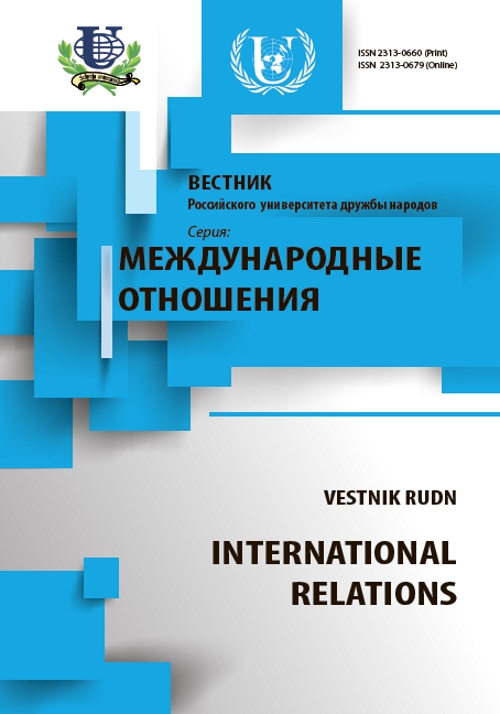Политика «мягкой силы» России и КНР в отношении стран Центральной Азии (на примере Казахстана)
- Авторы: Ван Г.1, Журавлева Е.В.2
-
Учреждения:
- Шаньдунский Университет
- Российский университет дружбы народов
- Выпуск: № 1 (2015): Восточная Азия: возвышение КНР, сотрудничество в целях развития, партнерство с РФ
- Страницы: 60-69
- Раздел: СТАТЬИ
- URL: https://journals.rudn.ru/international-relations/article/view/10370
- ID: 10370
Цитировать
Полный текст
Аннотация
Политика «мягкой силы» несколько утратила свое значение в российском внешнеполитическом курсе, но продолжает доминировать в умах исследователей. Доказательством тому служат многочисленные статьи, посвященные этой проблематике и даже изыскания журналистских кругов. Понятие давно уже стало своего рода трендом не только в области изучения международных отношений, но и политологии. Ключевым критерием для определения степени воздействия «мягкой силы» является «привлекательность», то есть насколько субъект может расположить к себе объект для того, чтобы оказывать на него определенное влияние. И Россия, и Китай обладают набором инструментов «мягкой силы», которые в той или иной степени позволяют им воздействовать на объекты, в том числе на страны Центрально-азиатского региона, включая Казахстан. Ввиду того, что КР неофициально стала лидером региона, на ее примере можно наиболее ярко проследить стремления России и Китая стать для Казахстана наиболее привлекательным партнером. Исследование опирается на компаративистский подход, что позволяет не только выявить особенности «мягкой силы» РФ и КНР, но сравнить их эффективность. Деятельность двух стран анализируется сквозь призму используемых в регионе инструментов «мягкой силы», в том числе инвестиций, образовательных, научных и культурных программ.
Об авторах
Гуанчжэнь Ван
Шаньдунский Университет
Email: sdwang66@163.com
Институт истории и культуры
Евгения Владимировна Журавлева
Российский университет дружбы народов
Email: janykabanova@gmail.com
Кафедра теории и истории международных отношений
Список литературы
- Лузянин С.Г. Центральная Азия: измерения безопасности и сотрудничества. URL: http://goo.gl/yvAAOE.
- Обзор по Казахстану. URL: http://www.worldbank.org/ru/country/kazakhstan/overview.
- Концепция внешней политики Российской Федерации. URL: http://www.mid.ru/brp_4.nsf/ 0/6D84DDEDEDBF7DA644257B160051BF7F.
- Сагиндиков Р.Е. Казахстанско-российские дипломатические отношения: состояние и перспективы // Вестник Российского университета дружбы народов. Серия «Международные отношения». 2014. № 2.
- Внешнеэкономическая деятельность. URL: http://www.ved.gov.ru/exportcountries/kz/ about_kz/ved_kz.
- Торговое представительство РФ в Республике Казахстан URL: http://www.rustrade.kz.
- Инвестиции в Казахстан от российских компаний составят 16 миллиардов долларов. URL: http://goo.gl/fv58Rd.
- Асылбеков М.Х., Асылбекова Ж.М., Баймаганбетова В.А., Енсенов К.А. и др. Население Казахстана по всесоюзной переписи населения 1939 года. [Электронный ресурс] // Алматы: Арыс, 2009. Т. 1. 400 c. URL: http://doc.nlrk.kz/result/ebook_124.
- Кузембайулы А., Абиль Е.А. История Казахстана: Учебник для вузов. Костанай: Костанайский региональный институт исторических исследований, 2006.
- Конституция Республики Казахстан. URL: http://www.constitution.kz/razdel1.
- Министерство образования и науки Республики Казахстан. URL: http://www.edu.gov.kz/ru.
- КНР занимает 2 место после РФ по числу казахстанских студентов. URL: http://forbes.kz/ news/2014/10/20/newsid_70795.
- Коваленко С.А., Смолик Н.Г. Участие РУДН в деятельности Сетевого университета СНГ // Вестник Российского университета дружбы народов. Серия «Международные отношения». 2014. № 4.
- Посольство Российской Федерации в Республике Казахстан. URL: http://www.rfembassy.kz.
- Влияние российских СМИ в Казахстане. URL: http://goo.gl/VqY0sK.
- Сатпаев: Российские СМИ теряют влияние в Казахстане. URL: http://news.nur.kz/ 309561.html.
- Комитет по статистике при Министерстве Национальной Экономики Республики Казахстан. URL: http://goo.gl/xtku9m.
- На Гуанчэн Отношения Китая и стран Центральной Азии (Na Guangcheng Zhongguo yu Zhongya guojia de guangxi). URL: http://src-h.slav.hokudai.ac.jp/publictn/85/9CA-Chinese.pdf.
- Министерство иностранных дел КНР. URL: http://www.fmprc.gov.cn.
- В газете «Экспресс К» опубликована авторская статья временного поверенного в делах посольства КНР в РК Сунь Вэйдуна. URL: http://kz.china-embassy.org/rus/sgxx/sgdt/ t1199322.htm.
- В РК 22 нефтяные компании с китайским участием. URL: http://forbes.kz/process/probing/v_ rk_rabotayut_22_neftyanyie_kompanii_s_kitayskim_uchastiem.
- Краткий статистический отчет за 2012 г. о студентах - иностранцах, приезжающих в Китай (2012 nian quanguo laihua liuxuesheng jianming tongji baogao). URL: http://www.moe.edu.cn/publicfiles/business/htmlfiles/moe/s5987/201303/148379.html.
- Китайско-казахстанские культурные связи (Zhongguo yu Hasakesitan de wenhua guanxi). URL: http://cpc.people.com.cn/n/2013/0905/c64387-22819235.html.
- Почему мы боимся китайских мигрантов? URL: http://goo.gl/ABfKPY.
- Адилханулы Н.А. Конкуренция ведущих зарубежных школ за будущее Казахстана // Вестник Российского университета дружбы народов. Серия «Международные отношения». 2014. № 4.
- Joseph S. Nye What China and Russia Don’t Get About Soft Power. URL: http://foreignpolicy.com/2013/04/29/what-china-and-russia-dont-get-about-soft-power.
Дополнительные файлы










